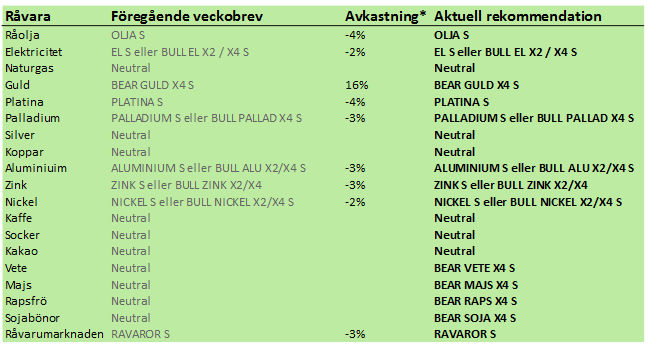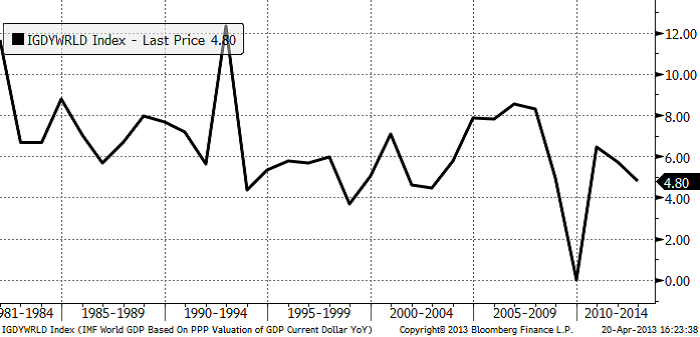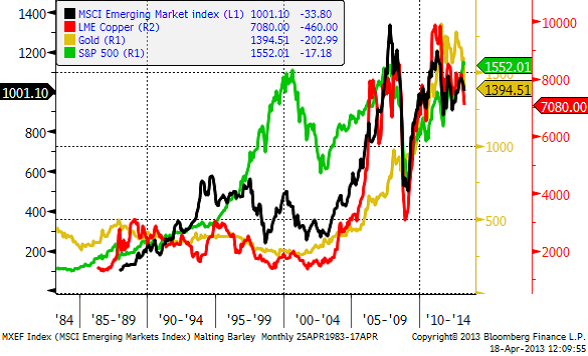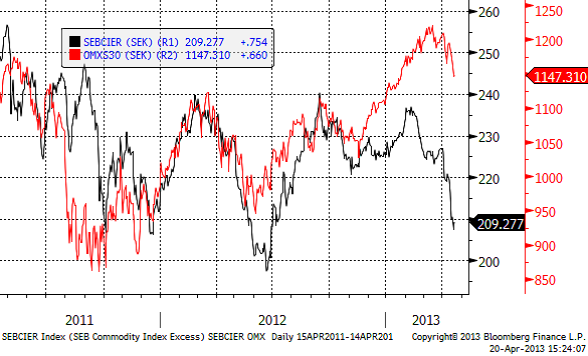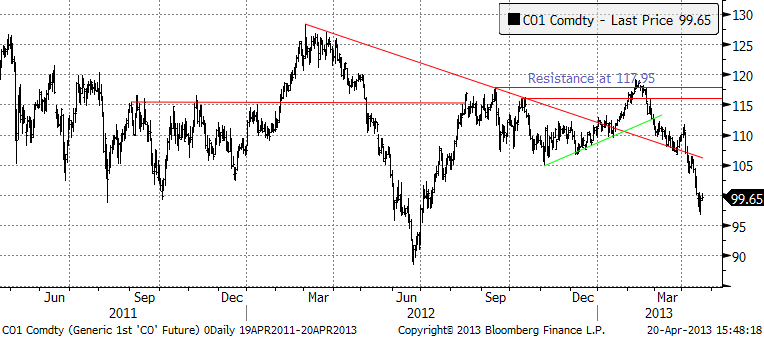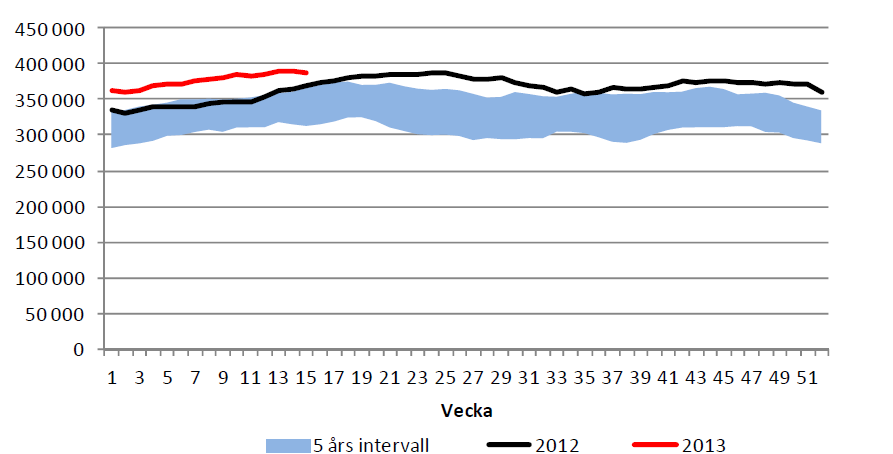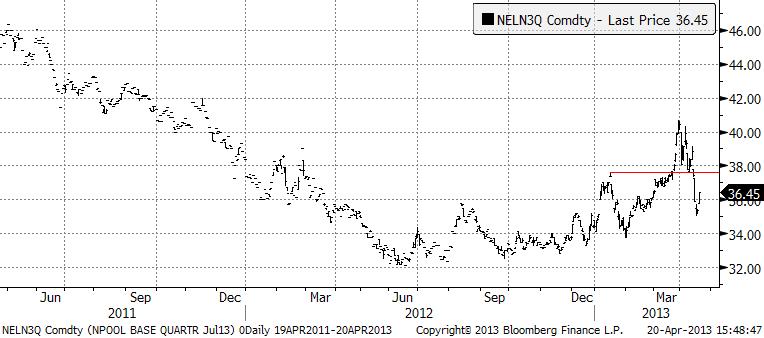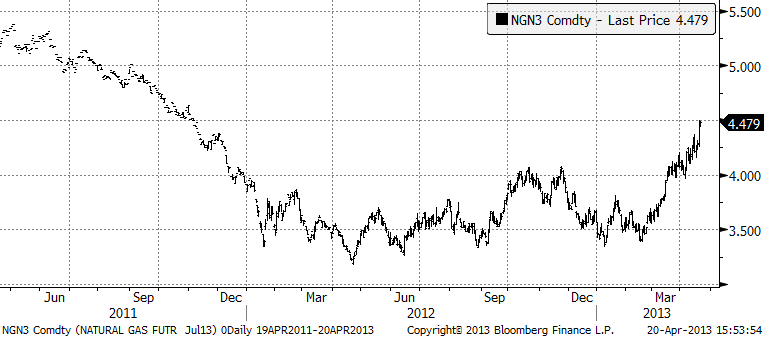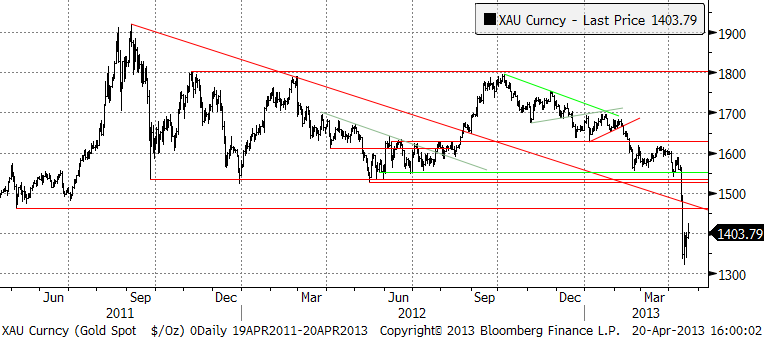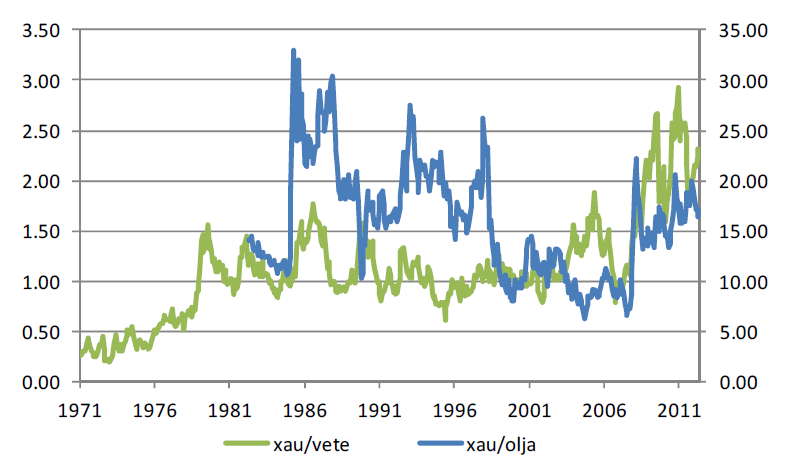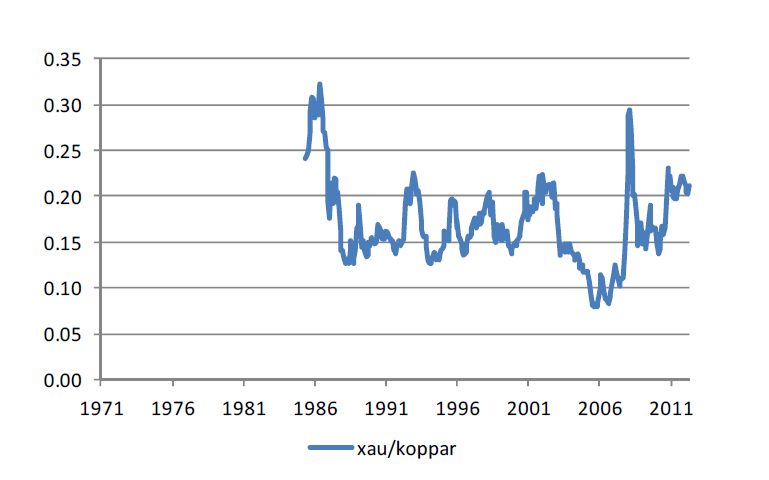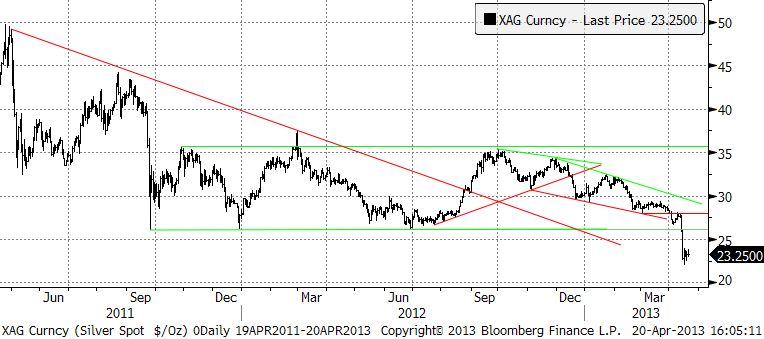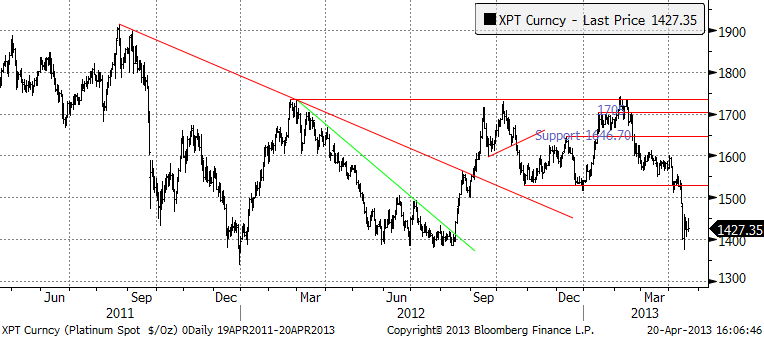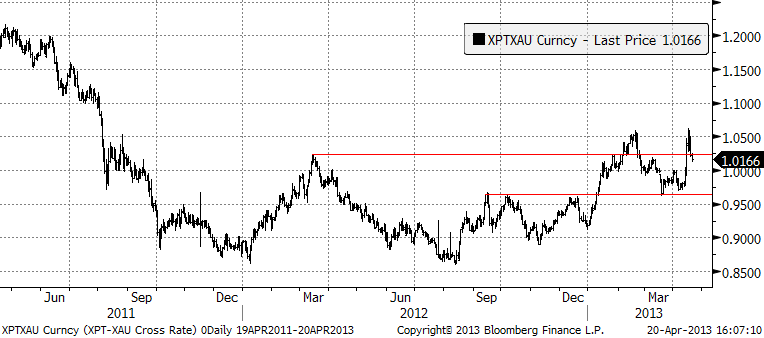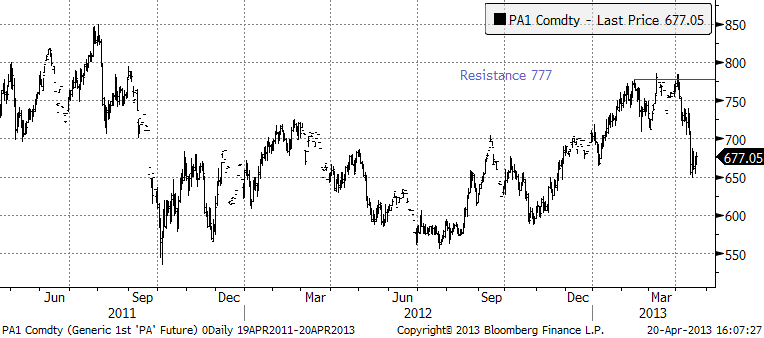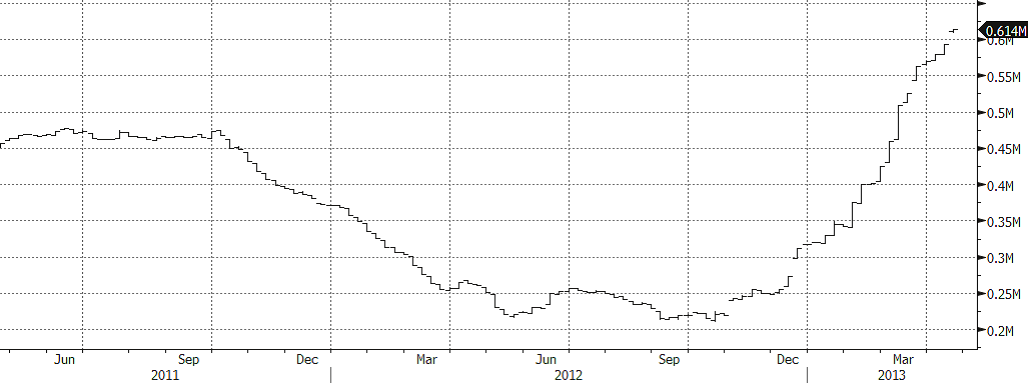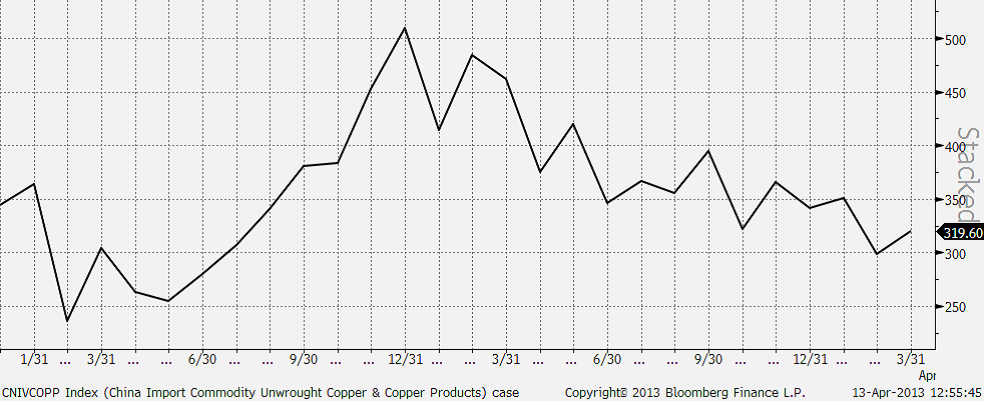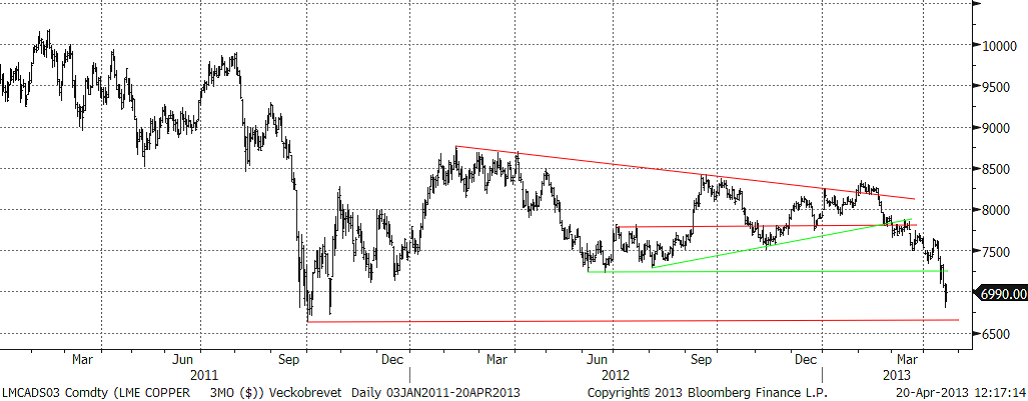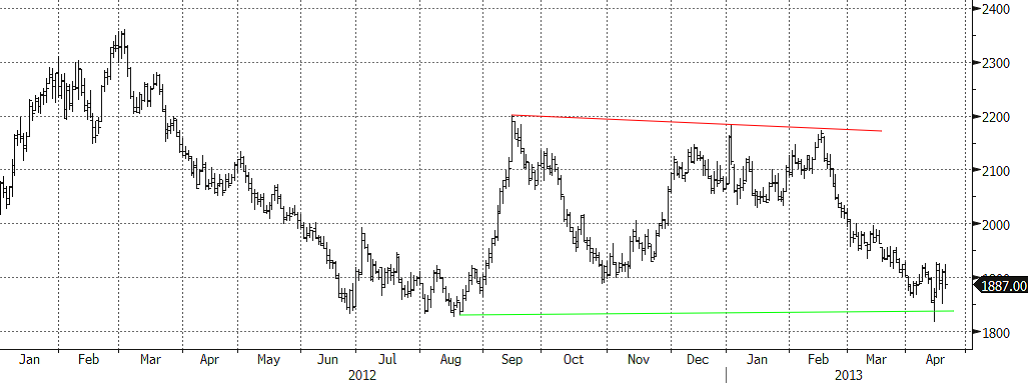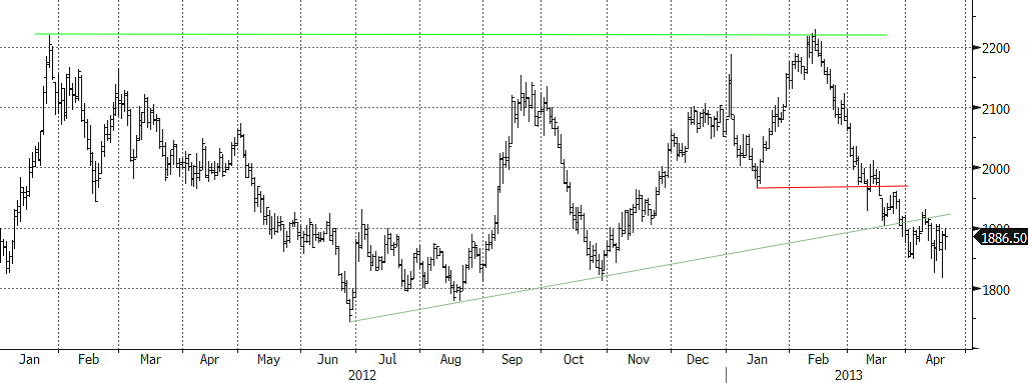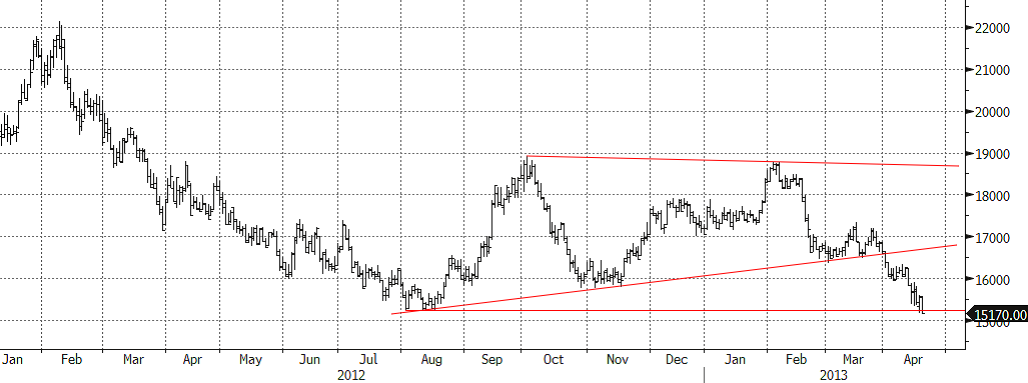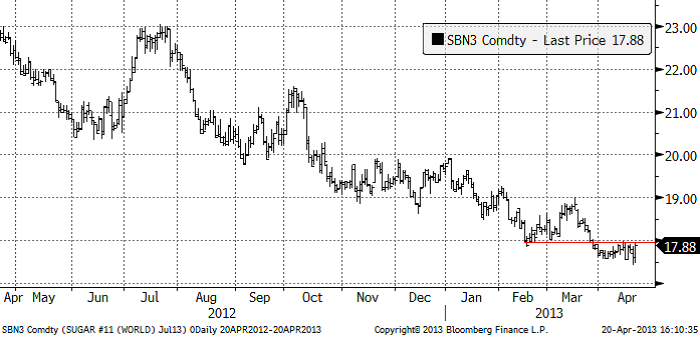Analys
SEB – Råvarukommentarer, 22 april 2013

Rekommendationer
*) Avkastningen avser 1:1 råvarucertifikat där de ingår i rekommendationen. I den aktuella tabellen ovan har jag tagit prisförändringen den senaste veckan sedan det förra veckobrevet publicerades.
** Positionen följde omedelbart vid publiceringen enligt texten i förra veckobrevet.
Inledning
Kinas BNP-statistik för det första kvartalet publicerades i början av veckan. Den hamnade på 7.7%. Marknaden hade väntat sig en tillväxt på 8%. Men det var industriproduktionen som var den stora besvikelsen. Den kom in på 8.9% tillväxt. Marknaden hade väntat sig 10.9% tillväxt. Detta slog framförallt mot bas- och ädelmetaller och på oljepriset. Även sojapriset kom på fall.
IMF sänkte därefter sin prognos för tillväxten i världen till endast 3.3%. Nedan ser vi historiken. 3.3% skulle placera global tillväxt på den näst lägsta nivån sedan 1980. Endast 2008 var sämre.
Råvarumarknaden styrs mest av hur det går i tillväxtländer. Om aktiemarknader är en ledande indikator för detta, låt oss titta på MSCI Emerging Markets index, guldpris och kopparpris.
Vi ser att råvarupriserna (både koppar och guld) har mycket gemensamt med aktieindex i tillväxtländerna. S&P 500 har väldigt dålig samvariation med råvarupriser. Emerging Markets-aktieindex toppade senast i febaruari och har gått ner sedan dess, precis som råvarorna. Båda är en reflektion av att den ekonomiska aktiviteten i tillväxtländerna är lägre än förut.
Råvaruindex
I diagrammet nedan ser vi SEB:s råvaruindex i svenska kronor och OMXS30 aktieindex. Vi ser att de gått åt helt olika håll fram till i veckan, då båda föll.
Den som vill investera i indexet och den investeringsstrategi som ligger bakom kan läsa mer om certifikatet RAVAROR S.
Råolja – Brent
Oljepriset inledde veckan med stora prisfall, liksom nästan alla råvaror. Mot slutet av veckan passade många konsumenter på att prissäkra sin konsumtion för de kommande månaderna. Vi tror att en stor del av detta hanns med förra veckan. Dessa företag är nu prissäkrade för flera månader framöver och med de köparna borta från köpsidan, finns risk för en förnyad svaghet i veckan som kommer.
Lagren och lagerförändringarna i USA den senaste rapportveckan ser vi nedan, enligt Department of Energy och American Petroleum Institute. Notera minskningen i råoljelagren!
Nedan ser vi amerikanska råoljelager enligt DOE i tusen fat. Den svarta kurvan är 2012 års lagernivåer vecka för vecka och den lilla röda linjen är 2013 års nivå. Nu ser alltså en minskning.
Importen har minskat för andra veckan i rad och ligger nu stadigt under 8 mbbl/dag.
Vi rekommenderar köp av OLJA S.
Elektricitet
Priset på el som var uppe på över 40 euro per MWh, har sedan dess rekylerat ner ordentligt. Vi tror att detta är ett köptillfälle.
Den hydrologiska balansen har fortsatt att falla, men i väderleksprognosen har det kommit in betydligt mer nederbörd. Därför är prognosen för den hydrologiska balansen om 10 veckor högre än den aktuella. Medan aktuell hydrologisk balans visar – 24.53 TWh, ligger prognosen om 10 veckor på -18.24 TWh.
Priset har trots allt kommit ner så långt att vi tycker att det tredje kvartalet är köpvärt på de här nivåerna. Vi rekommenderar därför köp av EL S.
Naturgas
Nedan ser vi juli-kontraktet på naturgas i USA. Det har varit en fin resa uppåt och vår rekommendation av BULL NATGAS X4 S har gett +17% sedan förra veckan. Vi tror att 4.50 är ett visst motstånd och det kan naturligtvis bli någon slags rekyl på den här nivån. Men rent tekniskt finns det en god möjlighet att priset fortsätter upp mot 5 dollar. Vi fortsätter alltså att rekommendera köp av BULL NATGAS X4 S.
Guld och Silver
Måndagens prisnedgång, för en vecka sedan, blev den största sedan början av 1980-talet och den tredje största sedan Bretton-Woods-systemet föll samman 1971. Det är naturligt att en sådan kraftig nedgång följs av en kortvarig rekyl. Det vanligaste är att en sådan rekyl är kortvarig och sedan följs av ytterligare en nedgång. Det är inte säkert att det blir så den här gången, men det är i alla fall så som historien lär oss att oddsen brukar vara.
Penningmängden har via de olika QE-programmen i USA fått en boost sedan 2009. Detta har gjort att guldpriset dragit iväg mer än det kanske skulle ha gjort om bara demografi drev priset. Den senaste veckan har FED börjat tala om ett slut på QE och vi ser också att M1 i USA börjat plana ut. Historien visar att detta påverkar guldpriset negativt. Emellertid har förra veckan svaga ekonomiska statistik gjort att man faktiskt skulle kunna tänka sig en återgång till QE. Om det sker ger det nytt bränsle för en prisuppgång på guld.
Guldpriset har också kommit ner till produktionskostnaden för 2013 (cash costs + capex). Detta gör att nya projekt kan komma att skjutas på framtiden, med minskat utbud som konsekvens. Detta är också stödjande för priset.
Ett annat sätt att studera priset på guld är att jämföra guldpriset med priset på andra råvaror. Nedan ser vi priset på guld dividerat med vete, respektive olja.
Nedan ser vi kvoten mellan guldpriset och kopparpriset.
Om vi beräknar medelvärdet för kurvorna ovan och multiplicerar detta med aktuellt pris för respektive råvara, får vi ett ”medelvärde” för guldpriset.
Vi ser att ”normalpriserna” 1537 dollar, 1274 dollar och 1765 dollar inte ligger så långt från dagens kursnivå. Ett aktuellt guldpris på 1403 dollar förefaller inte vara överdrivet ”högt” efter de prisfall som varit.
Om man ska sammanfatta läget kan vi se att många av de faktorer som har drivit upp priset sedan 2001 har tömts ut:
- Demografiska faktorer (Kinas tillväxt) börjar nå sitt slut. Kommer människorna i tillväxtländerna att fortsätta bli rikare?
- Gruvproduktionen ökar
- Gruvbolagen har köpt tillbaka alla sina hedgar
- Räntorna har gått ner till noll
Å andra sidan…
- QE kanske är över, penningmängdsfaktorn kanske är slut, men en eventuell inbromsning i USA:s ekonomi kan få FED att slå på kranarna igen.
- Räntenivåerna är rekordlåga och statsskulderna är rekordhöga. Det brukar leda till inflation.
- Prisfallet har fått guldpriset att gå ner till ”rimliga” nivåer jämfört med andra råvaror.
- Priset ligger inte långt över produktionskostnad
- Centralbanker har börjat köpa (det gjorde de dock också 1980
Den kortsiktiga psykologin i marknaden är den av baisse / nedgång. Men priset på guld är inte ”för högt” idag om inte resten av råvarumarknaden kraschar. Den som är långsiktig kan kanske leta köptillfällen, men inte än. Nedan ser vi kursdiagrammet för silver i dollar per troy ounce.
I det förra veckobrevet skrev vi att vi skulle gå kort om stödet vid 26 dollar bröts. Det bröts genast i måndags för en vecka sedan och vi ligger sedan dess köpta BEAR SILVER X4 S. Den tekniska analysen och beprövad erfarenhet, säger att priset borde gå ner till 20 dollar innan baissen är över.
Platina & Palladium
Platinapriset föll tillsammans med andra ädelmetaller. 1400 är sedan tidigare ett starkt stöd och där studsade priset i veckan som gick. Om den nivån bryts signaleras ytterligare prisnedgång.
Priset på platina i termer av guld steg initialt när guldpriset föll, men föll sedan tillbaka. Det ser ändå ut som om platina ligger i en stigande trend i förhållande till guld.
Palladium föll också ner med andra ädelmetaller. Priset nådde ner till 650 dollar innan det fann stöd. 650 dollar är egentligen inte någon ordentlig stödnivå. En sådan finns dock nere på 600 dollar. 700 dollar är däremot ett starkt motstånd på uppsidan.
Basmetaller
På metallmarknaden har blickarna generellt fokuserat på guldet och de ädla metallernas utveckling. Förra fredagens ras följdes av en lika stor nedgång under måndagen. Resten av veckan har passerat i återhämtningens tecken. Guldet uppvisade fyra uppdagar i rad fram till igår fredag. För basmetaller har utvecklingen varit blandad. Koppar ”smittades” av guldet och bröt viktiga tekniska nivåer som utlöste ett kraftigt fall i veckan. Nickel följde i viss mån efter. Aluminium och zink är däremot upp någon procent. Basmetallerna brukar röra sig olika mycket, men att de går åt olika håll är ganska ovanligt. Fundamental känns det dock ganska logiskt. De två senare metallerna ligger på väldigt låga nivåer ur ett kostnadsperspektiv, och möter starkt köpintresse på de här låga nivåerna. Nickel placerar vi i samma ”kostnadskategori” men där är överskottet för stort nu för att kunna hålla emot. Koppar har, som vi nämnt tidigare, fallhöjd och ligger mycket högre i marginalkostnad-pris perspektivet.
Koppar
Vi har tidigare varnat för kopparmarknadens fundamentala situation som håller på att vända från flera års ”kroniska” underskott som ständigt gett stöd till priset, till att nu sannolikt ha ett visst överskott, med lagerbyggnad som följd. LME-lagret uppgång är ett tecken på detta. När priset bröt igenom stödet vid $7250 gick det undan. Guldraset spred sig till koppar.
Veckans nivåer kring $6800 som lägst har inte setts sedan oktober 2011. Vi har nu fått den väntade korrigeringen. Tekniskt sett så (se grafen nedan) kommer nästa stödnivå in kring $6500. I vårt tycke har marknaden förmodligen korrigerat tillräckligt, med en anpassning till den ”nya” fundamentala situationen. Det blir nu extra intressant att följa Kinas import. Prisskillnaden mellan LME och Shanghai är till LME:s fördel, vilket brukar ledan till att kineserna ”passar på” att köpa. Frågan är dock hur stark efterfrågan är lokalt i Kina. Marknaden är lite tveksam. Vi bevakar nu kopparn och förebereder oss för att vända från neutral till köp.
LME-lager Koppar
Kinas kopparimport (Tton)
Den tekniska bilden har gett stöd till vår neutrala position. Vi är positiva till basmetaller på sikt men har avvaktat bättre köptillfällen alternativt väljer någon annan basmetall. Vi bevakar nu den nya stödnivån kring $6500.
Som vi skrivit tidigare tyder mycket på ökat utbud för koppar, vilket riskerar att begränsa uppgångspotentialen. Vi rekommenderar fortsatt en neutral position, men sätter koppar på bevakning för köp. För den som vill satsa på ett starkare tillväxtscenario (än konsensus) i Kina är koppar däremot alltid ett intressant alternativ.
Aluminium
Som vi skrev i ingressen är det ovanligt att metallerna divergerar, och speciellt koppar och aluminium, som är upp 1,6 % i veckan samtidigt som koppar faller 5 %! Vi såg starka köpintressen under veckan från industriella förbrukarare som köper på termin. Andra aktörer rapporterar samma typ av flöden. Varje gång marknaden ”dippar” under $1900 finns köparna där.
Tekniskt sett ser också veckoutvecklingen stark ut, med en ny botten i kombination med en uppåt-stängning. Vi skrev att nivåerna är intressant på lite sikt (6-12 månader). Kortsiktigt kan det vara läge för en stark uppgång nästa vecka. För den riskbenägne kan det vara läge för att köpa ett kontrakt med hävstång (BULL ALU X2 eller X4). Långsiktigt är nivån väldigt intressant för kontraktet Aluminium S (utan hävstång).
Zink
Utvecklingen för zink påminner om den för aluminium. Upp 0,7 % i veckan. Vi är i grunden positiva till zinken, men bilden störs av rapporter om ett överraskande stort utbud i Kina. Produktionen ökar mer än väntat, framför allt med tanke på de låga priserna. Risken är att det dröjer innan priset vänder upp på allvar. Fundamentalt är zinken ”billig” ur ett kostnadsperspektiv och nuvarande nivåer är mycket intressanta på lite längre sikt (6-12 månader). I det perspektivet är Zink S (utan hävstång) att föredra.
Nickel
Marknaden är fortsatt tveksam till den fundamentala situationen. Vi har tidigare bl.a. hänvisat till kommentarer från fysiska aktörer som indikerar att ”det finns gott om nickel”, samtidigt som rapporter gör gällande att exporten av nickelmalm från Indonesien till Kina ökar igen, vilket riskerar att öka utbudet av s.k. Nickel Pig Iron i Kina (vilket i sin tur minskar efterfrågan på nickelbärande skrot och primärnickel). För några veckor sedan ryktades det om en omsvängning, då kinesiska producenter är snabba att ställa om produktionen, vilket ger ett naturligt stöd till nickelmarknaden. Nya rykten gör dock gällande att Kina börjat exportera Nickel Pig Iron. LME-lagret är på all time high. Även om nivån är attraktiv ur ett kostnadsperspektiv, varnade vi förra veckan att det allmänna stämningsläget riskerar att sätta ytterligare press. Det var precis vad som hände. Vi ligger nu precis på stödnivån. Om metallerna generellt öppnar positivt måndag morgon finns förutsättningar för en snabb uppgång, men det är hög risk. Ett genombrott på nedsidan kan också skapa ytterligare teknisk press. Tekniskt orienterade aktörer är sannolikt redan exponerade för fortsatt nedgång, så frågan är om det finns ytterligare kraft att pressa ned priset.
Risken/möjligheten är därför stor att det finns behov att köpa tillbaka korta positioner, vilket också talar för en kortsiktig uppgång nästa vecka. Det bästa rådet på nickel är att avvakta veckans inledning, för eventuella kortsiktiga köp av hävstångsprodukter.
Kaffe
Kaffepriset (maj 2013) gick ner till nytt kontraktslägsta i början av veckan. Mot slutet av veckan vände dock priset upp. Därmed bröts ett av motstånden, men veckan stängde under den lilla toppen från månadsskiftet mars/april. Om den nivån överskrids har vi en liten positiv indikation på den trendvändning vi väntat på. Den stora nedåtgående motståndslinjen (röd i diagrammet) måste också helst brytas för att vi ska vilja köpa. Än så länge förhåller vi oss neutrala. Och väntar.
Socker
Sockerpriset (september 2013) föll i slutet av mars under 18 cent per pund. Marknaden har testat motståndet hela tiden. Samtidigt kommer rapporter från Brasilien om att regn ger ytterligare boost åt skördens storlek.
Vi fortsätter med neutral rekommendation.
[box]SEB Veckobrev Veckans råvarukommentar är producerat av SEB Merchant Banking och publiceras i samarbete och med tillstånd på Råvarumarknaden.se[/box]
Disclaimer
The information in this document has been compiled by SEB Merchant Banking, a division within Skandinaviska Enskilda Banken AB (publ) (“SEB”).
Opinions contained in this report represent the bank’s present opinion only and are subject to change without notice. All information contained in this report has been compiled in good faith from sources believed to be reliable. However, no representation or warranty, expressed or implied, is made with respect to the completeness or accuracy of its contents and the information is not to be relied upon as authoritative. Anyone considering taking actions based upon the content of this document is urged to base his or her investment decisions upon such investigations as he or she deems necessary. This document is being provided as information only, and no specific actions are being solicited as a result of it; to the extent permitted by law, no liability whatsoever is accepted for any direct or consequential loss arising from use of this document or its contents.
About SEB
SEB is a public company incorporated in Stockholm, Sweden, with limited liability. It is a participant at major Nordic and other European Regulated Markets and Multilateral Trading Facilities (as well as some non-European equivalent markets) for trading in financial instruments, such as markets operated by NASDAQ OMX, NYSE Euronext, London Stock Exchange, Deutsche Börse, Swiss Exchanges, Turquoise and Chi-X. SEB is authorized and regulated by Finansinspektionen in Sweden; it is authorized and subject to limited regulation by the Financial Services Authority for the conduct of designated investment business in the UK, and is subject to the provisions of relevant regulators in all other jurisdictions where SEB conducts operations. SEB Merchant Banking. All rights reserved.
Analys
Tightening fundamentals – bullish inventories from DOE

The latest weekly report from the US DOE showed a substantial drawdown across key petroleum categories, adding more upside potential to the fundamental picture.

Commercial crude inventories (excl. SPR) fell by 5.8 million barrels, bringing total inventories down to 415.1 million barrels. Now sitting 11% below the five-year seasonal norm and placed in the lowest 2015-2022 range (see picture below).
Product inventories also tightened further last week. Gasoline inventories declined by 2.1 million barrels, with reductions seen in both finished gasoline and blending components. Current gasoline levels are about 3% below the five-year average for this time of year.
Among products, the most notable move came in diesel, where inventories dropped by almost 4.1 million barrels, deepening the deficit to around 20% below seasonal norms – continuing to underscore the persistent supply tightness in diesel markets.
The only area of inventory growth was in propane/propylene, which posted a significant 5.1-million-barrel build and now stands 9% above the five-year average.
Total commercial petroleum inventories (crude plus refined products) declined by 4.2 million barrels on the week, reinforcing the overall tightening of US crude and products.


Analys
Bombs to ”ceasefire” in hours – Brent below $70

A classic case of “buy the rumor, sell the news” played out in oil markets, as Brent crude has dropped sharply – down nearly USD 10 per barrel since yesterday evening – following Iran’s retaliatory strike on a U.S. air base in Qatar. The immediate reaction was: “That was it?” The strike followed a carefully calibrated, non-escalatory playbook, avoiding direct threats to energy infrastructure or disruption of shipping through the Strait of Hormuz – thus calming worst-case fears.

After Monday morning’s sharp spike to USD 81.4 per barrel, triggered by the U.S. bombing of Iranian nuclear facilities, oil prices drifted sideways in anticipation of a potential Iranian response. That response came with advance warning and caused limited physical damage. Early this morning, both the U.S. President and Iranian state media announced a ceasefire, effectively placing a lid on the immediate conflict risk – at least for now.
As a result, Brent crude has now fallen by a total of USD 12 from Monday’s peak, currently trading around USD 69 per barrel.
Looking beyond geopolitics, the market will now shift its focus to the upcoming OPEC+ meeting in early July. Saudi Arabia’s decision to increase output earlier this year – despite falling prices – has drawn renewed attention considering recent developments. Some suggest this was a response to U.S. pressure to offset potential Iranian supply losses.
However, consensus is that the move was driven more by internal OPEC+ dynamics. After years of curbing production to support prices, Riyadh had grown frustrated with quota-busting by several members (notably Kazakhstan). With Saudi Arabia cutting up to 2 million barrels per day – roughly 2% of global supply – returns were diminishing, and the risk of losing market share was rising. The production increase is widely seen as an effort to reassert leadership and restore discipline within the group.
That said, the FT recently stated that, the Saudis remain wary of past missteps. In 2018, Riyadh ramped up output at Trump’s request ahead of Iran sanctions, only to see prices collapse when the U.S. granted broad waivers – triggering oversupply. Officials have reportedly made it clear they don’t intend to repeat that mistake.
The recent visit by President Trump to Saudi Arabia, which included agreements on AI, defense, and nuclear cooperation, suggests a broader strategic alignment. This has fueled speculation about a quiet “pump-for-politics” deal behind recent production moves.
Looking ahead, oil prices have now retraced the entire rally sparked by the June 13 Israel–Iran escalation. This retreat provides more political and policy space for both the U.S. and Saudi Arabia. Specifically, it makes it easier for Riyadh to scale back its three recent production hikes of 411,000 barrels each, potentially returning to more moderate increases of 137,000 barrels for August and September.
In short: with no major loss of Iranian supply to the market, OPEC+ – led by Saudi Arabia – no longer needs to compensate for a disruption that hasn’t materialized, especially not to please the U.S. at the cost of its own market strategy. As the Saudis themselves have signaled, they are unlikely to repeat previous mistakes.
Conclusion: With Brent now in the high USD 60s, buying oil looks fundamentally justified. The geopolitical premium has deflated, but tensions between Israel and Iran remain unresolved – and the risk of missteps and renewed escalation still lingers. In fact, even this morning, reports have emerged of renewed missile fire despite the declared “truce.” The path forward may be calmer – but it is far from stable.
Analys
A muted price reaction. Market looks relaxed, but it is still on edge waiting for what Iran will do

Brent crossed the 80-line this morning but quickly fell back assigning limited probability for Iran choosing to close the Strait of Hormuz. Brent traded in a range of USD 70.56 – 79.04/b last week as the market fluctuated between ”Iran wants a deal” and ”US is about to attack Iran”. At the end of the week though, Donald Trump managed to convince markets (and probably also Iran) that he would make a decision within two weeks. I.e. no imminent attack. Previously when when he has talked about ”making a decision within two weeks” he has often ended up doing nothing in the end. The oil market relaxed as a result and the week ended at USD 77.01/b which is just USD 6/b above the year to date average of USD 71/b.

Brent jumped to USD 81.4/b this morning, the highest since mid-January, but then quickly fell back to a current price of USD 78.2/b which is only up 1.5% versus the close on Friday. As such the market is pricing a fairly low probability that Iran will actually close the Strait of Hormuz. Probably because it will hurt Iranian oil exports as well as the global oil market.
It was however all smoke and mirrors. Deception. The US attacked Iran on Saturday. The attack involved 125 warplanes, submarines and surface warships and 14 bunker buster bombs were dropped on Iranian nuclear sites including Fordow, Natanz and Isfahan. In response the Iranian Parliament voted in support of closing the Strait of Hormuz where some 17 mb of crude and products is transported to the global market every day plus significant volumes of LNG. This is however merely an advise to the Supreme leader Ayatollah Ali Khamenei and the Supreme National Security Council which sits with the final and actual decision.
No supply of oil is lost yet. It is about the risk of Iran closing the Strait of Hormuz or not. So far not a single drop of oil supply has been lost to the global market. The price at the moment is all about the assessed risk of loss of supply. Will Iran choose to choke of the Strait of Hormuz or not? That is the big question. It would be painful for US consumers, for Donald Trump’s voter base, for the global economy but also for Iran and its population which relies on oil exports and income from selling oil out of that Strait as well. As such it is not a no-brainer choice for Iran to close the Strait for oil exports. And looking at the il price this morning it is clear that the oil market doesn’t assign a very high probability of it happening. It is however probably well within the capability of Iran to close the Strait off with rockets, mines, air-drones and possibly sea-drones. Just look at how Ukraine has been able to control and damage the Russian Black Sea fleet.
What to do about the highly enriched uranium which has gone missing? While the US and Israel can celebrate their destruction of Iranian nuclear facilities they are also scratching their heads over what to do with the lost Iranian nuclear material. Iran had 408 kg of highly enriched uranium (IAEA). Almost weapons grade. Enough for some 10 nuclear warheads. It seems to have been transported out of Fordow before the attack this weekend.
The market is still on edge. USD 80-something/b seems sensible while we wait. The oil market reaction to this weekend’s events is very muted so far. The market is still on edge awaiting what Iran will do. Because Iran will do something. But what and when? An oil price of 80-something seems like a sensible level until something do happen.
-

 Nyheter4 veckor sedan
Nyheter4 veckor sedanUppgången i oljepriset planade ut under helgen
-

 Nyheter3 veckor sedan
Nyheter3 veckor sedanMahvie Minerals växlar spår – satsar fullt ut på guld
-

 Nyheter4 veckor sedan
Nyheter4 veckor sedanLåga elpriser i sommar – men mellersta Sverige får en ökning
-

 Nyheter2 veckor sedan
Nyheter2 veckor sedanOljan, guldet och marknadens oroande tystnad
-

 Analys4 veckor sedan
Analys4 veckor sedanVery relaxed at USD 75/b. Risk barometer will likely fluctuate to higher levels with Brent into the 80ies or higher coming 2-3 weeks
-

 Nyheter2 veckor sedan
Nyheter2 veckor sedanJonas Lindvall är tillbaka med ett nytt oljebolag, Perthro, som ska börsnoteras
-

 Analys3 veckor sedan
Analys3 veckor sedanA muted price reaction. Market looks relaxed, but it is still on edge waiting for what Iran will do
-

 Nyheter2 veckor sedan
Nyheter2 veckor sedanDomstolen ger klartecken till Lappland Guldprospektering


